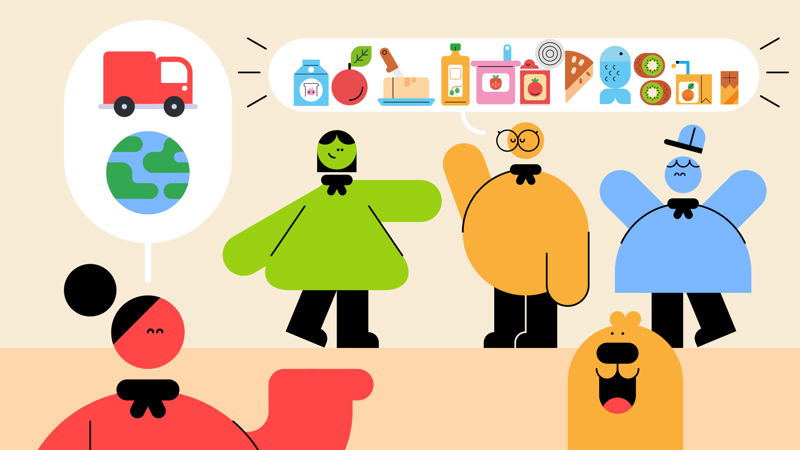
Track your food footprint
You’ll need
- Coloured pens or pencils
Before you begin
- You’ll need to do this activity across three meetings, and people will need to track their food waste at home too.
- You’ll need enough copies of the ‘Love food hate waste diary’ sheets for everyone to take one away with them.
If you don’t want to print the ‘Love food hate waste diary’ sheets, everyone could draw their own tables they can use to monitor the food they throw away or save, the meal it’s from, how it’s thrown away or saved, and who throws it away or saves it
- You’ll also need to share the ‘Asto-nosh-ing food facts’ and ‘Easy peasy food saver tips’ with everyone. These can be found in the dropdowns below – you could print them out or write them on a whiteboard or some big pieces of paper.
Learn the facts
- Everyone should split into small groups. The person leading the activity should share the ‘Asto-nosh-ing food facts’ with each group.
- Everyone should chat about the facts on their sheet.
-
- How might food waste affect the group, the people they live with, their community, and other people across the world?
- How might it affect the planet? How does it make people feel?
- Why is it important that people do something about food waste?
If you’ve got time, explore the topic further by learning about climate change or global warning. What else can you find out about the food that’s thrown away in the UK and across the world?
- The person leading the activity should give everyone a ‘Food waste diary’. They should make sure everyone understands what they need to put in each of the boxes.
Make sure you give everyone the first one, about food that’s thrown away.
- Everyone should take their ‘Food waste diary’ home and put it somewhere it’s easy to see (for example, on the kitchen wall). They should complete it for a week.
People can get creative with their diaries – they don’t have to stick to writing information down, they could draw or cut out pictures from old newspapers and magazines.
Make a change
- Everyone should split into groups.
You might want to remind everyone to be respectful and kind to each other throughout their discussions.
- Everyone should chat about their food diaries. Which foods did they throw away most? Why? The ‘when’ and ‘why’ of the diary should help everyone figure this out. The people leading the activity should help everyone with their discussions.
People could think about both the amount of food and the frequency. For example, a bit of bread every day might add up to a lot, while leftovers that have gone bad might be a lot of food but a one-off.
- Everyone should make some notes about the foods they want to try to save over the next week.
You might want to gather the food diaries in and keep them somewhere safe for the next session.
- Everyone should look at the ‘Easy peasy food saver tips’. They should decide on two or three actions that they want to try over the next week to help them cut down on food waste.
- The person leading the activity should give everyone a new ‘Love food hate waste diary’ sheet. They should make sure everyone understands what they need to put in each of the boxes.
Make sure you give everyone the second one, about food that’s saved.
- Everyone should share the actions they’ve chosen with the people they live with and encourage them to try their best too.
- Everyone should complete their new food diaries. Again, they can get creative with pictures and collages.
Compare and share
- Everyone should split into small groups.
- Each group should compare their diaries from week one and week two. How much food did they save from the bin? How could they continue to save food in future?
- The person leading the activity might decide to finish up the session by turning some leftover food into a tasty meal or snack.
Check out Make food matter for delicious pizzas made of leftovers.
Get inspired to cut down on food waste with these asto-nosh-ing facts:
- Around 3 million glasses of milk are chucked away in the UK each day. This is enough to fill 110 Olympic-sized swimming pools every year.
- Every day 20 million slices of bread are thrown away in UK homes. This could have fed breakfast to 10 million people and, a year’s worth of wasted bread slices, laid end-to-end, could circle the Earth from pole-to-pole 28 times.
- At least 1/3 of all edible food produced across the world never gets eaten. This is enough to feed 2 billion people – just over 1/4 of the world’s population.
- An average British family can save £840 a year if they stopped throwing their food in the bin. This could go towards a holiday, buy 28 winter coats for young people, or pay for 32 family trips to the cinema.
- Pop half your loaf of bread in the freezer when you get home from the shop. You can then make toast straight from the freezer and never bin a slice again.
- A lot of food is chucked away as it’s gone off and not been eaten in time. Chill your fridge out and keep it at a lovely cool temperature of 5 °C or below.
- Buy loose fruit and veg. That way you can buy only what you’ll eat, rather than buying a huge bag that you end up chucking half of in the bin.
Reflection
This activity was about being a citizen and making the world a better place. People kept diaries that showed how much food was thrown away when it could’ve been saved. How did they feel when they saved food from the bin? Was it easy to do? What did people learn in this activity? Will they change anything they do to stop more food being thrown away? Why is it important to tackle food waste? People might remember that food waste has a huge impact on the environment because lots of resources, time, and energy go into producing food. Despite this, a third of food produced globally isn’t eaten. How could people share what they’ve learned with others in their community to make an even bigger difference?
Safety
All activities must be safely managed. You must complete a thorough risk assessment and take appropriate steps to reduce risk. Use the safety checklist to help you plan and risk assess your activity. Always get approval for the activity, and have suitable supervision and an InTouch process.
If it’s too difficult to keep a diary for a whole week, focus on doing a few days really well. People will still be able to see where food is wasted and saved.
- Remember that not everyone’s home situations are similar. Some people may have less control over how food’s purchased, stored, and served (for example, looked after children in residential settings or people who use food banks). If you think this is likely to affect a lot of your group, you could think about doing this activity a different way, for example, during a trip or camp.
- There are all sorts of reasons people might find food tricky, including eating disorders and autism. Encourage everyone to be respectful and kind, and don’t single anyone out. All anyone can do is try their best!
- Anyone who struggles with reading and writing can use pictures for their diaries. If they find maths tricky, you could spend a few minutes helping them do the adding up at the start of each session.
All Scout activities should be inclusive and accessible.
If this activity’s got people excited about stopping food waste, why not lead a campaign to help others in your community become food savers? It may even count towards your Community Impact Staged Activity Badge.



